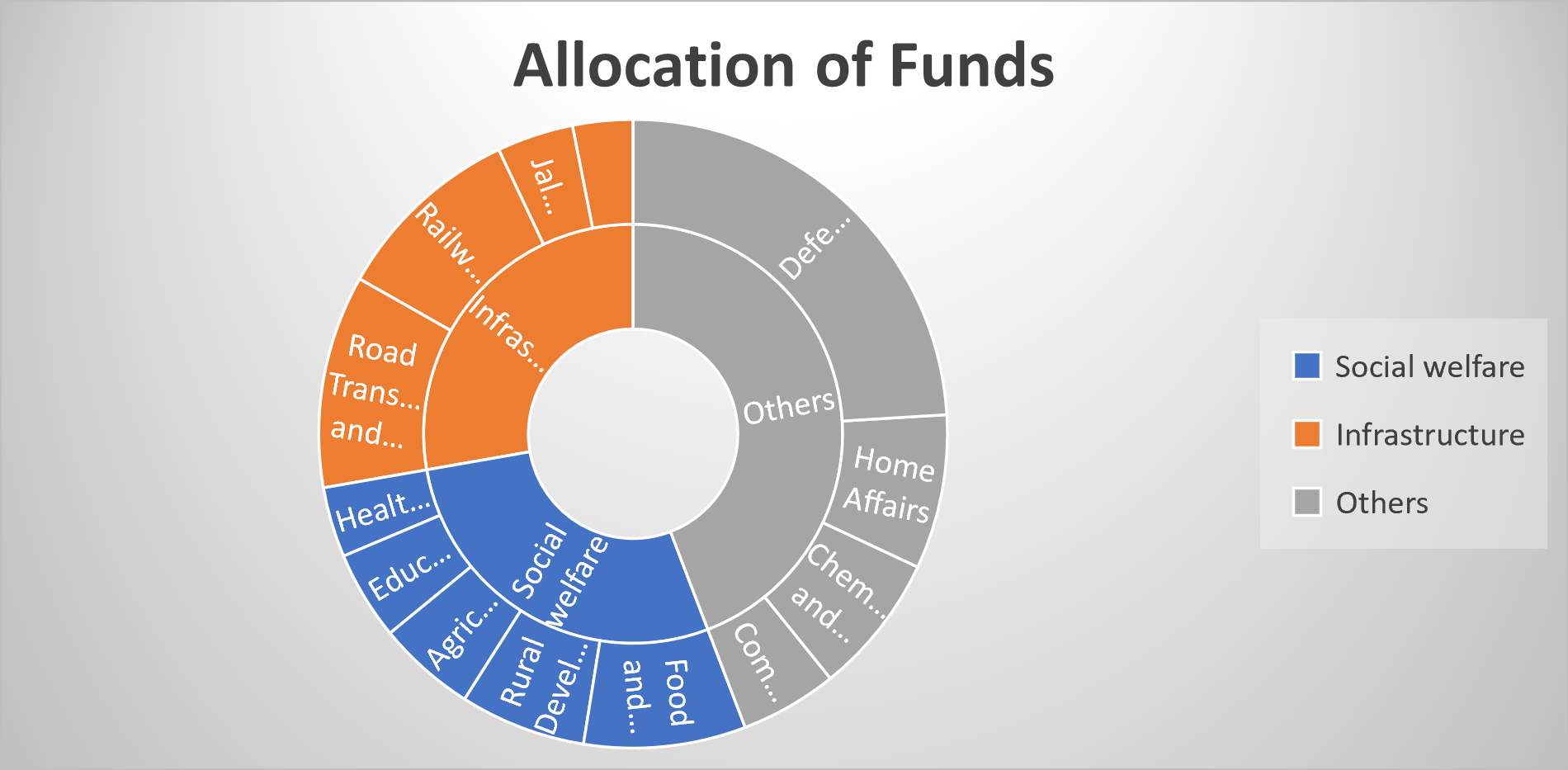Since Independence in 1947, the Indian government has presented a total of 73 annual budgets, 14 interim budgets and 4 special budgets. And in February 2023 again, the Customary Annual Union Budget has made headlines as the Finance Minister presented gift-like Budget for the Financial Year 2023-24 with the aims to further strengthen India’s economic status. The efficient implementation of many schemes, with universalisation of targeted benefits, has resulted in inclusive development. Some of the schemes are:
- 11.7 crore household toilets under Swachh Bharat Mission,
- 9.6 crore LPG connections under Ujjawala,
- 220 crore Covid vaccination of 102 crore persons,
- 47.8 crore PM Jan Dhan bank accounts,
- Insurance cover for 44.6 crore persons under PM Suraksha Bima and PM Jeevan Jyoti Yojana, and
- Cash transfer of ` 2.2 lakh crore to over 11.4 crore farmers under PM Kisan Samman Nidhi.
New Tax Regime becoming the Show Stopper and proposed Regulatory changes are much delved upon. Out of many announcements, few are provided below to accustom corporates with forth coming changes. Once the Bill gets passed, follow up exercise to amend targeted Laws will commence. Further, to understand changes proposed under Customs, GST, Income Tax, specific address will be made.
The Budget has set following Saptrishi-7 priorities for the coming year:
- Inclusive Development
- Building Digital Public accessible Infrastructure for farmers.
- Setting Agriculture Accelerator Fund.
- Rs. 20 Lakhs Crore Agriculture Credit targeted for Animal Husbandry, Dairy and Fishing Sector.
- Setting storage capacity.
- New programmes to promote research in Pharmaceuticals to be launched.
- Reaching the Last Mile
- Pradhan Mantri PVTG Development Mission to be launched.
- Financial assistance to be given for sustainable micro irrigation in drought prone regions of Karnataka.
- More teachers to be recruited for 740 Eklavya Model Residential Schools.
- Bharat(SHRI) to be set up for inscriptions.
- >Infrastructure and Investment
- Increased capital investment outlay by 33.4% to l0 lakh crore.
- Continuation of 50 year interest free loan to State Governments to incentivize infrastructure investment.
- Highest ever Capital outlay of 12.4 lakh crore for Railways.
- Unleashing the Potential
- AI based solutions in agriculture, health and sustainable cities.
- National Data Governance Policy to Enable access to anonymized data for research by Start-ups and academia.
- Faster settlement of contractual disputes of Govt. and Govt. undertakings.
- Facilitating secure online storing and sharing of documents with the business ecosystem.
- Green Growth
- PM- PRANAM to be launched to incentivize States/UTs to promote usage of alternative fertilizers.
- Amrit Dhamhar to be implemented for optimal usage of wetlands.
- Setting up 10,000 bio- inputs resource centres-to facilitate farmers to adopt natural farming.
- Promotion of Battery established storage system.
- Youth Power
- At least 50 destinations to be selected to be developed as a complete package for domestic and foreign tourists.
- Covering new courses like coding, AI, Robotics etc.
- States to be encouraged to have unity malls.
- Financial Sector
- Setting up of National Information registry to enable efficient lending. promote financial inclusion and enhance financial stability
- Enhanced maximum deposit limit for senior citizens savings scheme from Rs.15 lakh to Rs.30 lakh
- Expanded corpus under a revamped scheme to enable additional collateral free guaranteed credit of 12 lakh crore
It’s interesting how Government is mixing Environment with Finance and Business, for instance the introduction of Sovereign Green Bonds, Green Debt Securities, Extended Producer Responsibility, Business Responsibility and Sustainability Reporting etc. Indeed, various innovative announcements can be deduced from this Budget and Policy as well.
ALLOCATION OF FUNDS:
The Allocation of funds and dedication of flow towards initiatives and plans needs to be understood as follows:

In 2023-24, the ministries with the highest allocations account for 55% of the estimated total expenditure. Of these, the Ministry of Defence has the highest allocation in 2023-24, at Rs 5,93,538 crore. It accounts for 13.2% of the total budgeted expenditure of the central government. Other ministries with high allocation include: (i) Road Transport and Highways (6% of total expenditure), (ii) Railways (5.4%), and (iii) Consumer Affairs, Food, and Public Distribution (4.6%). Table shows the expenditure on Ministries with the 10 highest allocations for 2023-24 and the changes in allocation as compared to the revised estimate of 2022-23.
| S.No. | MINISTRIES | BUDGET 2023-2024 (in lakh crores) | % CHANGE (2022-23 RE To 2023-2024 BE) |
|---|---|---|---|
| 1. | Ministry of Defence | Rs. 5.94 | 1.5% |
| 2. | Ministry of Road Transport & Highways | Rs. 2.7 | 24.6% |
| 3. | Ministry of Railways | Rs. 2.4 | 48.6% |
| 4. | Ministry of Public & Food Distribution | Rs. 2.06 | -30.6% |
| 5. | Ministry of Home Affairs | Rs. 1.96 | 1.1% |
| 6. | Ministry of Chemicals & Fertilisers | Rs. 1.78 | -21.6% |
| 7. | Ministry of Rural Development | Rs. 1.60 | -12.3% |
| 8. | Ministry of Agriculture & Farmers Welfare | Rs. 1.25 | 5.1% |
| 9. | Ministry of Communications | Rs. 1.23 | 17.0% |
| 10. | Ministry of Housing & Urban Affairs | Rs. 0.76 | 2.5% |
Fiscal Responsibility and Budget Management targets
The Fiscal Responsibility and Budget Management (FRBM) Act, 2003 requires the central government to progressively reduce its outstanding debt, revenue deficit and fiscal deficit. The objectives of the Act are-
- Introduce transparent fiscal management systems in the country.
- Introduce more equitable and manageable distribution of the country’s debts over the years.
- Aim for fiscal stability for India in the long run.
- Ensure public debt does not increase to 50% of the GDP.
The Central Government gives 3 year rolling targets for the indicators when it presents the Union Budget each year. Medium Term Fiscal Policy Statement in both 2021-22 and 2022-23 did not provide rolling targets for budget deficits. In the Budget speech, the finance minister noted that the government aims to reduce fiscal deficit to below 4.5% of GDP by 2025-26.
Fiscal deficit is an indicator of borrowings by the government for financing its expenditure. The estimated fiscal deficit for 2023-24 is 5.9% of GDP.
Revenue deficit is the excess of revenue expenditure over revenue receipts. Such a deficit implies the government’s need to borrow funds to meet expenses which may not provide future returns. The estimated revenue deficit for 2023-24 is 2.9% of GDP.
Primary deficit is the difference between fiscal deficit and interest payments. It is estimated to be 2.3% of GDP in 2023-24.
| S.No. | Deficits | Actuals 2021-22 | Revised 2022-23 | Budgeted 2023-24 |
|---|---|---|---|---|
| 1. | Fiscal Deficit | 6.7% | 6.4% | 5.9% |
| 2. | Revenue Deficit | 4.4% | 4.1% | 2.9% |
| 3. | Primary Deficit | 3.3% | 3.1% | 2.3% |
For 2023-24, the total receipts other than borrowings and the total expenditure are estimated at Rs.27.2 lakh crore and Rs.45 lakh crore respectively. The net tax receipts are estimated at Rs.23.3 lakh crore. The fiscal deficit is estimated to be 5.9% of GDP. In Budget Speech for 2021-22, it was announced that plan to continue the path of fiscal consolidation, reaching a fiscal deficit below 4.5% by 2025-26 with a fairly steady decline over the period.
CONCLUSION
Business houses and Start-ups can make a lot out of this Budget. In the form of announcements, Government has opened multiple opportunities in infrastructural sector, manufacturing, trade etc. The aim of reducing compliance responsibility and enhancing regulatory grip over corporates is evident. Simplifying business process, in terms of registrations, approvals, customs, filings etc is to ensure ease of doing business. Giving due attention to bring up the Digital age, via Digilocker, Digital Payments, Single Window to reach multiple authorities.
Budget and Finance Bill have touched diverse areas. It is intriguing to see how these plans and announcements will take shape of actual schemes, frameworks and Amendments.
Disclaimer
The information provided in this article is intended for general informational purposes only and should not be construed as legal advice. The content of this article is not intended to create and receipt of it does not constitute any relationship. Readers should not act upon this information without seeking professional legal counsel.



